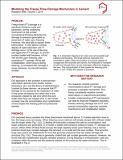| dc.description.abstract | Freeze-thaw (FT) damage is a significant threat to roads and pavement, yet the underlying mechanism is still unclear. Conventional thinking attributes the damage to pressure generated by expansion of water upon freezing. However, this idea fails to explain three phenomena: 1) only above a critical degree of water saturation will FT damage occur; 2) the use of de-icing salt aggravates FT damage; 3) cement mortars loaded with benzene, a fluid that shrinks upon freezing, also experience FT damage. While salt crystallization, which occurs during freezing, is correlated with damage in some instances, its role still remains unclear. | en_US |
